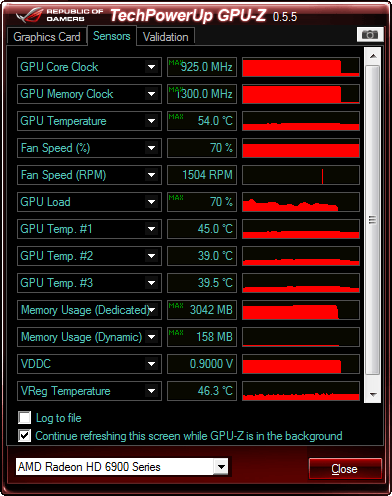

- #GPU Z MEMORY USAGE DEDICATED VS DYNAMIC DRIVERS#
- #GPU Z MEMORY USAGE DEDICATED VS DYNAMIC DRIVER#
- #GPU Z MEMORY USAGE DEDICATED VS DYNAMIC SERIES#
- #GPU Z MEMORY USAGE DEDICATED VS DYNAMIC FREE#
Launch XenCenter and confirm through console the GPUs are runningī. It is not possible so see which application is using the framebuffer via nvdia-smi, nvidia-smi is querying the silicon not the VM.īeginning XS6.2 and later, Citrix XenServer supports access to most performance counters from NVML.Ī. However it should be noted that nvidia-smi only lets you access metrics for the whole physical GPU and if there are multiple VMs sharing the GPU, the results pertain to the whole GPU and not resources used by a particular VM. It is possible to monitor the whole physical GPU via the nvidia-smi utility within the hypervisor.
#GPU Z MEMORY USAGE DEDICATED VS DYNAMIC FREE#
Some of the free and generally available methods and the steps to use them are: Monitoring the GPU utilization resources on the host

There are multiple tools and methods to achieve this. To get an accurate measure of the GPU utilization for a particular deployment, we need to investigate both the host utilization and frame buffer utilization inside a VM. Current advice for new deployments is to use the K120Q / K220Q profiles rather than the K100 / K200 vGPU profiles. Those artefacts are the same as seen on physical GPUs which have the same framebuffer and should be expected on physical servers as well as virtualised if too small a framebuffer is used. When vGPU was initially launched there were vGPU profiles such as the K100 and K200 with a small 256MB framebuffer, users often noted corruptions when using Unigine Heaven which requires a minimum of 512MB framebuffer. Note at the time of writing it is not possible to measure the vGPU processing load per VM or from within a VM.Įvery GPU or vGPU has an allocated frame buffer: ESRI ArcGIS, Petrel and CAD applications handling very large parts. This is most likely to be the case on applications involving large data sets e.g. For some applications though the GPU framebuffer available maybe the bottleneck, limiting performance. Typically for most applications, one resource will be exhausted before the others, often this is CPU. To understand application performance you need to consider factors such as IOPS, RAM, CPU, GPU, vCPU contention and networking. In any case, no, there isn't anything that Tensorflow can use.Usually a 3D/CAD/graphically rich application will be limited by a particular resource.
#GPU Z MEMORY USAGE DEDICATED VS DYNAMIC DRIVER#
Look in the advanced settings of the NVIDIA driver for a setting that controls this. It could also not be real memory but just a memory mapped area that corresponds to GPU memory. This may be eg extra texture memory, etc.
#GPU Z MEMORY USAGE DEDICATED VS DYNAMIC DRIVERS#
Uninstaller the Intel drivers and/or disable Intel HD graphics in the BIOS and shared memory will disappear. (a) You have both NVIDIA and Intel graphics drivers active (eg as happens when running different displays on both). I can think of a couple of possibilities:

Why do you see that kind of memory being allocated when you have a NVIDIA card in your machine? Good question. In practice, running a GPU compute task on data which is too big to fit in GPU memory and has to be transferred over PCIe every time it is accessed is so slow for most types of compute that doing the same calculation on CPU would be much faster. It won't be useful because system RAM bandwidth is around 10x less than GPU memory bandwidth, and you have to somehow get the data to and from the GPU over the slow (and high latency) PCIE bus.ĭDR4 on desktop motherboard: approx 25GB/s Tensorflow can't use it when running on GPU because CUDA can't use it, and also when running on CPU because it's reserved for graphics.Įven if CUDA could use it somehow. This is not on your NVIDIA GPU, and CUDA can't use it.
#GPU Z MEMORY USAGE DEDICATED VS DYNAMIC SERIES#
This type of memory is what integrated graphics eg Intel HD series typically use. Shared memory is an area of the main system RAM reserved for graphics.


 0 kommentar(er)
0 kommentar(er)
